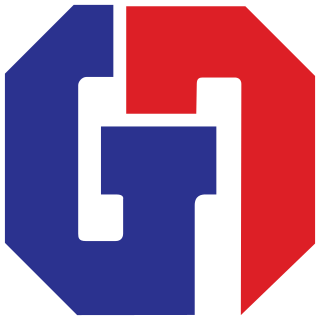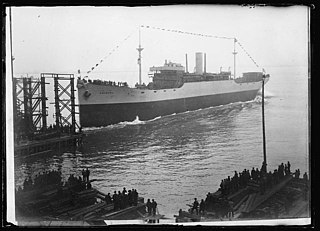
Harland & Wolff is a British shipbuilding and fabrication company headquartered in London with sites in Belfast, Arnish, Appledore and Methil. It specialises in ship repair, shipbuilding and offshore construction. Harland & Wolff is famous for having built the majority of the ocean liners for the White Star Line, including Olympic-class trio – RMS Olympic, RMS Titanic and HMHS Britannic. Outside of White Star Line, other ships that have been built include the Royal Navy's HMS Belfast; Royal Mail Line's Andes; Shaw, Savill & Albion's Southern Cross; Union-Castle's RMS Pendennis Castle; P&O's Canberra; and Hamburg-America's SS Amerika of 1905. Harland and Wolff's official history, Shipbuilders to the World, was published in 1986.

Van der Giessen de Noord was a shipbuilding company that mainly built ferries, located in Krimpen aan den IJssel, a town in the western Netherlands. The yard was especially suited to the construction of large vessels due to its developed undercover facilities.

NOV Inc., formerly National Oilwell Varco, is an American multinational corporation based in Houston, Texas. It is a worldwide provider of equipment and components used in oil and gas drilling and production operations, oilfield services, and supply chain integration services to the upstream oil and gas industry. The company conducts operations in more than 500 locations across six continents, operating through three reporting segments: Rig Technologies, Wellbore Technologies, and Completion & Production Solutions.

SBM Offshore N.V. is a Dutch-based global group of companies selling systems and services to the offshore oil and gas industry. Its constituent companies started their offshore activities in the early 1950s and SBM subsequently became a pioneer in single buoy moorings (SBM) systems. The firm leases and operates Floating Production Storage and Offloading vessels, and is involved in the design and engineering, construction, installation, operation and maintenance of floating production equipment for the offshore Oils and Gas industry. It is a main board listed company on the Euronext Amsterdam stock exchange and has been a member of the AEX index since 2003. It has been engulfed by a massive corruption scandal in Brazil.

Cochin Shipyard Ltd (CSL) is the largest shipbuilding and maintenance facility in India. It is part of a line of maritime-related facilities in the port-city of Kochi, in the state of Kerala, India. Of the services provided by the shipyard are building platform supply vessels and double-hulled oil tankers. It built the first indigenous aircraft carrier for the Indian Navy, the INS Vikrant. The company has Miniratna status.

Mazagon Dock Shipbuilders Limited (MDL), formerly called Mazagon Dock Limited, is a shipyard situated in Mazagaon, Mumbai. It manufactures warships and submarines for the Indian Navy and offshore platforms and associated support vessels for offshore oil drilling. It also builds tankers, cargo bulk carriers, passenger ships and ferries.

The Rotterdamsche Droogdok Maatschappij (RDM) was the largest pre-World War II shipbuilding and repair company in Rotterdam in the Netherlands, existing from 1902 to 1996. It built 355 mostly major seagoing vessels, 18 of which were submarines. During its existence, the wharf operated 12 floating docks and in its heyday employed 7,000 people at one time.

Wilton-Fijenoord was a shipbuilding and repair company in Schiedam, Netherlands from 1929 to 1999. Presently, the shipyard of Wilton-Feijnoord is part of Damen Shiprepair Rotterdam.

Fop Smit was a Dutch naval architect, shipbuilder, and shipowner. He founded the towage and salvage company L. Smit & Co that is now part of Smit International. His shipyard had a number of "firsts" in shipbuilding and produced a number of famous vessels.

The Merchant Shipbuilding Corporation was an American corporation established in 1917 by railroad heir W. Averell Harriman to build merchant ships for the Allied war effort in World War I. The MSC operated two shipyards: the former shipyard of John Roach & Sons at Chester, Pennsylvania, and a second, newly established emergency yard at Bristol, Pennsylvania, operated by the MSC on behalf of the U.S. Shipping Board's Emergency Fleet Corporation (EFC).

Bharati Defence and Infrastructure Limited is one of the largest shipbuilding companies in India.
Reliance Naval and Engineering Limited (R-Naval), formerly known as Reliance Defence & Engineering Limited and prior to that as Pipavav Shipyard Limited and Pipavav Defence & Offshore Engineering Company Limited is an Indian shipbuilding and heavy industry company headquartered in Mumbai. The shipyard is located in Pipavav, Gujarat, at a distance of 90 km South of Amreli, 15 km South of Rajula and 140 km South West of Bhavnagar. R-Naval is the first private sector company in India to obtain a license and contract to build warships. Pipavav is the largest shipyard in India.

The shipbuilding company Rijn-Schelde-Verolme Machinefabrieken en Scheepswerven NV (RSV) was a combination of shipbuilding companies and machine factories founded in 1971. In 1983 the company went broke with a staggering loss of public money. It led to the Parliamentary inquiry about RSV.

Yavuz, ex Deepsea Metro I, is a Turkey-flagged ultra deepwater drillship owned and operated by the state-owned Turkish Petroleum Corporation (TPAO). She is Turkey's second drillship.

Wilton's Dok- en Werf Maatschappij was a Dutch shipbuilding company active as an independent company from 1854 till 1929. At first it was simply known as 'Wilton'. In 1921 the final Dutch name became: 'Wilton's Dok- en Werf Maatschappij NV', the equivalent of 'Wilton Engineering and Slipway Company'. Wilton started as a traditional smithy and expanded in machinery. It specialized in ship repairs, but also became a shipyard. At first only for fresh water ships. In spite of multiple name changes the company was commonly referred to as 'Wilton'. In 1929 a merger with Fijenoord led to a new company known as Wilton-Fijenoord.

J. & K. Smit was a Dutch shipbuilding company located in Kinderdijk and Krimpen aan de Lek. Its successor is now part of Royal IHC.

Royal IHC or Koninklijke IHC, previously IHC Holland (1943–1995), IHC Holland Merwede (1995–2005) and IHC Merwede (2005–2014) is a Dutch shipbuilding company with headquarters in Kinderdijk. It focuses on the development, design and construction of ships for the dredging and offshore industries.

Bethlehem Beaumont Shipyard was a shipyard in Beaumont, Texas that opened in 1948. The yard is located on an island in the Neches River and upstream of the Sabine Pass that grants access to the Gulf of Mexico. The deep-water port shipyard was founded in 1917 as the Beaumont Shipbuilding & Dry Dock Company. Beaumont Shipbuilding & Dry Dock Company started as a World War I Emergency Shipbuilding Program yard.

L. Smit en Zoon previously known as Fop Smit, was a Dutch shipbuilding company located in Kinderdijk. Its successor is now part of Royal IHC.

Verschure & Co's was a shipbuilding company and machine factory in Amsterdam.























